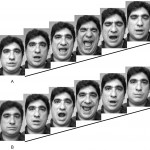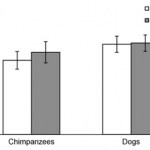dog
I will be reposting some dog-related posts from the archives in the coming few weeks as I prepare for the course I'm teaching this semester on dog cognition. Please let me know if you find something inaccurate or unclear.
Domesticated dogs seem to have an uncanny ability to understand human communicative gestures (see here). If you point to something the dog zeroes in on the object or location you're pointing to (whether it's a toy, or food, or to get his in-need-of-a-bath butt off your damn bed and back onto his damn bed). Put another way, if your attention is on something, or if your…
Different dog growls mean different things, right? Probably. But can you tell the difference?
Here's a dog growling when someone is trying to steal its food: link to mp3.
Here's a dog growling at a stranger: link to mp3.
You probably can't tell the difference. Neither could I. Dogs can. Surprised? Probably not. But, this is the first experimental evidence that dogs use different communicative vocalizations during social encounters with other dogs and with humans, depending on the situation.
The researchers recorded dog growls in three contexts: food guarding from another unfamiliar dog (…
Only a few minutes today to get out a few interesting links, because I'm busy writing up an IACUC proposal.
First, a post on dogs from one of the Psychology Today blogs. I think he's mostly wrong. And will probably spend some time over the weekend writing a post about it.
Second, another post on dogs from Jesse Bering's blog at Scientific American, Bering in Mind. This one I can get behind.
Why do I have dogs on the mind so much this week? Because I'm prepping for a short "mini-course" I'm teaching to Intro Psych students this Fall, on dog cognition. Here's the summary I wrote up:
How do dogs…
It's been a pretty long stressful week around here, and not just because of Pepsipocalypse and the resulting fallout. But, well, I'm back, and I have an awesome paper to tell you about. When I saw it I just KNEW it had to be blogged.
Mythbuster Adam Savage sets the yawning in motion in Mythbusters attempts to start a yawning epidemic across the globe
Did watching that video make you yawn? Chances are it did, and you can thank contagious yawning for it. What is contagious yawning? Contagious yawning is a very well-dcoumented phonemenon wherein yawning is triggered by the perception of others…
Happy Father's Day, everyone!
I spent a lot of time today thinking back to why I started blogging in the first place, while I was at my parents house doing the other-than-science things that I love to do: playing with the dog, cooking, gardening. I realized that I've not done enough of that stuff lately.
I've only been seriously doing the blog thing (in the current format) since January, and I've now been here at Scienceblogs around two months, so it was time to reflect. The transition from Wordpress obscurity to Scienceblogs prominence happened relatively quickly for me, and I think it's a…
Once upon a Thursday night, blog bff Scicurious asked a particular blogger named Jason if he had access to a paper titled, Contraceptive efficacy of polyester-induced azoospermia in normal men. "I certainly hope so," he said. And so he logged in to his university's library proxy website, and searched for the paper.
She said, "PLEASE PLEASE PLEASE tell me you have access to this article" and then "it's about ball sacks I MUST HAVE IT." As it happens, he did have institutional access. So Jason downloaded it. It was a rather large file, so it took a little while for him to upload it to his Gmail…
Dogs are particularly good at tasks that involve communicating or cooperating with humans, which has led some researchers to speculate that they are really good at solving social tasks, more generally. For example, dogs can figure out where a human's attention is, are really good at picking up on eye-gaze and finger pointing cues, distinguish among different individual humans (by contrast, humans are really bad at distinguishing among different individual monkeys, for example), and at least in one outstanding case, are capable of "fast mapping."
Relative to non-human primates, domestic dogs…
I've decided I want to cover some recent research on social cognition in domesticated dogs. But first, we need some background. So here's a repost from the old blog.
Today I want to tell you about one of my most favorite studies, ever, of animals. Are you ready? It's a FIFTY YEAR LONG longitudinal study of captive silver foxes in Russia. Gather around, pour yourself a cup of your favorite beverage, get comfortable, and enjoy storytime.
In 1948, Soviet scientist Dmitri Belyaev lost his job at the Department of Fur Animal Breeding at the Central Research Laboratory of Fur Breeding in Moscow…
Yesterday Dr. Isis informed the world that, unfortunately, Isis the Dog passed away. A sad day in the life of any pet owner, I imagine it is especially troubling for Little Isis.
Being the proprietor of the SB home for all things animal and thoughtful, I asked the goddess if I could construct a blog memorial for him, and so I have.
Feel free to leave a message for the Isis clan in the comments below.
The skull of Nyctereutes lockwoodi as seen from the side and above. From Geraads et al, 2010.
In 2006 paleoanthropologists working in Ethiopia made a spectacular announcement - they had found the well-preserved remains of a juvenile Australopithecus afarensis, one of our prehistoric hominin relatives. Quickly dubbed "Lucy's baby" this 3.4 million year old specimen graced the cover of Nature and numerous news reports, yet its description represents only a fraction of the paleontological work being done in the area. Many other fossil animals have been found along the banks of the Awash, too…
Lately, a paper to be published in the June edition of the American Naturalist has been getting some attention. The findings that are getting reported out of this paper didn't make sense to me, but I wondered if this was an issue with accuracy in reporting. So I went and found the paper. Turns out that the reporting is accurate, its the actual findings from the paper that confuse me. I really wanted to make sense of this paper, so I've been waiting a while to blog about it. But I can't make sense of one key finding.
Figure 1: An artist's rendition of me, being confused. If, you know, I were…
...and what can word-learning in dogs teach us about the evolution of language in humans?
What is involved in the learning of a single new word? Consider the word "tiger", being learned by a child with already a modest vocabulary, at least for animal words. First the child must make a new entry in the mental lexicon - that "tiger" is a word in the first place. He has to categorize it as a noun. It has to be categorized under "animal" (a supernym) and related to its hyponyms, like "Sumatran tiger." Then, of course, the child has to learn what actual *thing* the word "tiger" refers to. Now,…
Let me tell you a little story. When I was born my parents had two cats. One was named Garfield. The other...well, I don't remember what the other one was called. Not long after I was born, and little Jason was coughing up furballs, the doctors informed the parents that their little bundle of skin and hair was allergic to cats. It was then that teams were picked and lines were drawn. It was me or the cats. Luckily, the parents decided to keep me, and lose the cats. Imagine how much it would have sucked if they decided to keep the cats and lose me. I imagine if my younger brother had actually…
Animals dream, too!
It's definitely not a seizure, and it's definitely not random motor actions. Those actions are totally coordinated. Poor dog must have been dreaming about a dog fight or something.
Dog owners have a way - sometimes within DAYS of first becoming dog owners - of becoming EXPERTS on animal behavior. It blows my mind. These are people who observe their animals displaying interesting or curious behaviors and make up things like "dogs like being put in tiny cages, actually, because of when their ancestors were pack animals and lived in caves."
Figure 1: Do they look happy to you? I didn't think so.
That said, a reader sent me an email inquiring about a particular behavior that she has observed in her female poodle. This reader is not one of the above-described self-…
The party isn't over yet! Here's another helping of Monday Pets. Enjoy!
Wild Dog crawled into the Cave and laid his head on the Woman's lap... And the Woman said, "His name is not Wild Dog any more, but the First Friend."
--Just So Stories, Rudyard Kipling.
Archaeological evidence indicates that dogs were already a part of human society around the end of the Ice Age. Small dog skeletons have been unearthed in human communities as far back as 6- to 12-thousand years ago in Europe, the Middle East, and China. The jawbone of a domestic dog was found in a late Paleolithic grave in Germany, and…
The party continues! Today you get a double-dose of Monday Pets. Here's one from the archives. Later today, you can expect a new one.
I often write about animals that the average person does not interact with all that much on a day-to-day basis. Today, I introduce something I like to call "Monday Pets". The focus of Monday Pets will be the animals that we intentionally bring into our lives as pets. Sometimes those animals are even considered part of the family. Ever notice some weird behavior that you notice your pets doing? Want to know more about it? Email me. Always wanted to know if your…
Our temporary houseguest, Rusty, playing in a stream in northern New Jersey.
I gave a talk today for a group of local home-school students and parents, on the essential elements of quantum physics. The idea was to give them a sense of what sets quantum mechanics apart from other theories of physics, and why it's a weird and wonderful thing.
The title is, of course, a reference to How to Teach Physics to Your Dog, and the second slide was an embedded version of the Chapter 3 reading. I set the talk up to build toward the double-slit experiment with electrons, using the video of the experiment made by Hitachi. Here's the talk on SlideShare:
What Every Dog Should Know…
What's the application? The use of lasers to provide an entertaining light show for humans, dogs, or cats.
What problem(s) is it the solution to? 1) "How will I entertain my dog or cat?"
2) "How can we distract people from the fact that Roger Daltrey has no voice left?"
Why are lasers essential? Lasers provide coherent beams of light, which remain small over very large distances, allowing you to project a small spot or a tight beam across a room, or even a football stadium.
Why is it cool? Duuuuude! Lasers, duuuuude!
Why isn't it cool enough? 1) It's fundamentally just a toy. 2) No amount…











